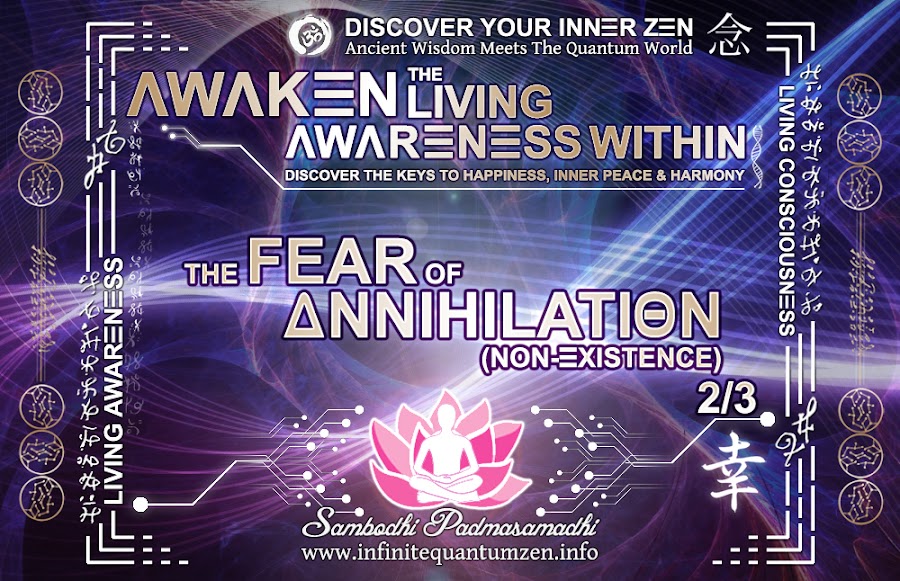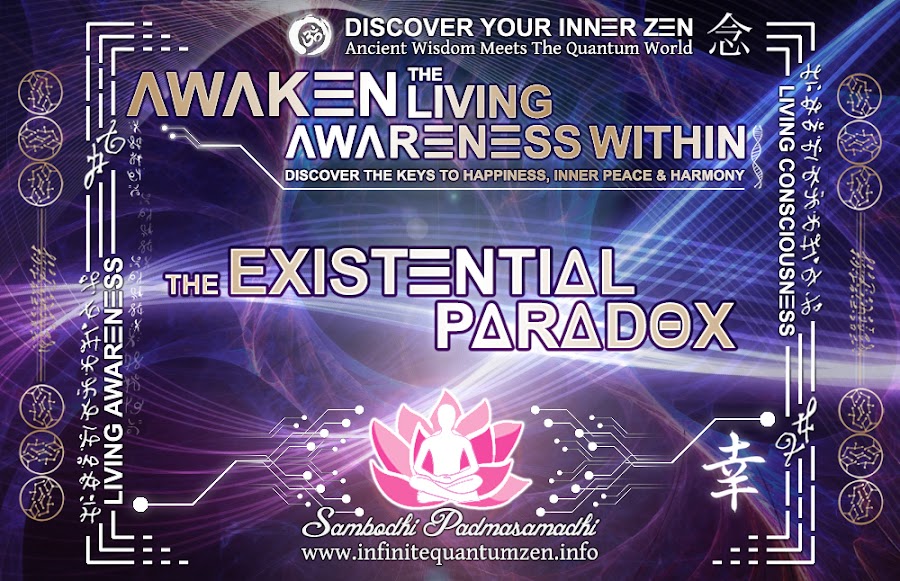 |
| ~ ∞ ~ The Fear of Annihilation (Non-Existence) ~ ∞ ~ |
So now, then, if we consider the idea of non-existence, we would find that by definition, non-existence doesn’t exist, and therefore existence cannot become non-existence. In other words, that which exists cannot become that which does not exist – simply because there is no such thing as non-existence in existence.
Of course we can talk about it and think that we are talking about non-existence, but in all actuality, we are not, for you see, the very term ‘non-existence’ exists within existence, and hence ‘non-existence’ in all of its essence is made out of existence itself. Furthermore, existence has only one quality – to exist; that is its fundamental state, you see?
Because we as individuals are an aspect, a reflection of existence – therefore it is our fundamental state as well. We exist, because we do, and we are here, because we exist. Even though this may seem profoundly simple, for most people – it isn’t.
Now, let us explore this in the context of science in terms of energy, frequency, and vibration, shall we? One doesn’t have to look very far to see that what we call life is the combination of ever-changing physical and mental energies; and that energy is eternal – meaning that we are infinite on a quantum scale, are we not?
According to Quantum Physics, everything already exists in a ‘pre-extant’ state, or simply in ‘pre-existence,’ out of which everything comes into manifestation through form (pattern, order, quality) into substance (matter, structure, quantity) when that something is being observed.
When we combine this with the mass–energy equivalence, or simply E=mc2 equation (which states that energy equals matter, thus being interchangeable; mass=energy and energy=mass), it gets pretty interesting. You see, Einstein’s law of conservation dictates that Energy cannot be created or destroyed, only transformed.
Now, what does that mean? Well, you do the math. Considering that Light is the Origin – the Source of everything that comes into being, the Source of everything we term as “real, concrete, tangible, material, physical.” Considering that Light is Energy, and matter is densified Light Energy.
Considering that just in the same way as water, steam, and ice are all the same one thing, same substance vibrating at different frequencies, so in the same way matter and energy are the same substance vibrating at different frequencies. Considering that all “things” are essentially the same one thing – vibrating at different rates or frequency. Considering that reality is not composed of discrete building blocks, but rather webs of relationships that are interrelated and interdependent.
Considering all that, and taking into account that most of us believe in the idea of a Soul or Spirit – the formless and timeless part of us that makes us who we are – the essence that is often compared to Light – it does add up, doesn’t it? That everything is made up of Light, of photons in different arrangement, of energy, of consciousness, of awareness. So now, then, what does that say about us human beings? Well, you do the math.
What’s fascinating about this is that if we break down matter over and over, we end up with octaves of light energy that breaks down into octaves of consciousness, which goes on to say that ultimately the light in every reality membrane is consciousness. In other words, all things are Spirit vibrating at different frequencies. Matter is therefore solidified energy; Spiritual energy vibrating at a slower frequency.
This means that our bodies are solidified Spirit, crystallized Spirit, you see? Considering the fact that physical and mental energies that constitute the so-called being have within themselves the power to take a new form, grow gradually and gather force to the full – does it not, indeed, mean that with the physical death, our energy only transforms, and we disperse back to the universe? Our cells, every fiber of us – from atoms to the tiniest particle; the very essence of us being made of the same composition of the cosmos – goes back to whence it once came.
And now, let us explore this from another perspective. If one can comprehend the aforementioned, then it should not be difficult to comprehend the following either. Just in the same way as the aforementioned physical and mental energies that constitute the so-called being disperse back to whence they once came, so in the same way does our Souls.
Even though the identity that we have constructed during our life might come to an end – it does not mean that the underlying consciousness and its purest form – Living Awareness, our Spiritual Essence would cease to exist. Like a river flowing into the sea, the Soul or Self eventually returns to its Source, becoming one with the Ultimate Truth, leading to the final goal or destination – absorption of Soul or Self into the Ultimate Reality, you see?
As you can imagine, there are many paths to take, and countless ways to tread the path, which brings us to the next aspect of the same. You see, when the physical body is no more capable of functioning – energies and consciousness don’t die with it, but instead, they propagate through various levels of existence, and eventually continue to take some other shape or form that some would call “another life.” One might call this transition from existence to post-existence, “afterlife.”
Upon deeper examination, one finds that every moment we are born and die, but still we continue. Life, therefore, is an unbroken series that continues but changes every moment – this movement is like a flame that burns through the night: it’s not the same flame nor is it another.
This brings us to conclude that both, birth and death – are gateways through which Life passes in and out of time in physical existence, which goes on to say that the difference between death and birth is only a thought-moment: the last thought-moment in this life conditions the first thought-moment in the so-called “next life,” which is the continuity of the same series, you see?
Considering everything that was discussed and brought to light in this chapter, the question remains: Why can’t we see death as a natural part of life – as a continuation and transformation rather than annihilation? After all, in death, we only become more of what we already are as spiritual beings, but on a more deeper level – see?
___
~ ॐ ~ Sambodhi Padmasamadhi ~ ∞ ~
Get the Book: Awaken the Living Awareness Within – Discover the Keys to Happiness, Inner Peace & Harmony
~ ॐ ~ Sambodhi Padmasamadhi ~ ∞ ~
Get the Book: Awaken the Living Awareness Within – Discover the Keys to Happiness, Inner Peace & Harmony
[ Click » here « to read the next part: Change Is the Only Constant – The Existential Paradox: Part III ]















